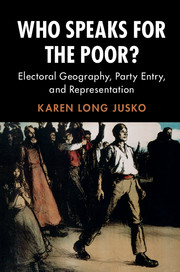Book contents
- Frontmatter
- Dedication
- Epigraph
- Contents
- List of Figures
- List of Tables
- Preface and Acknowledgments
- 1 Who Speaks for the Poor?
- 2 How Electoral Geography Matters
- 3 New Parties and the Changing Electoral Geography of Contemporary Democracies, 1880–2000
- 4 The Populists and “Third-Party Men” in America
- 5 Strategic Entry of the CCF and Social Credit in Canada
- 6 The Implications of Electoral Geography for British Labour
- 7 The Swedish Social Democratic Party, and the Long-Term Implications of Electoral Reform
- 8 “It Didn't Happen Here”: The General Implications of Electoral Geography for the Political Representation of the Poor
- References
- Index
- Miscellaneous Endmatter
4 - The Populists and “Third-Party Men” in America
Published online by Cambridge University Press: 05 September 2017
- Frontmatter
- Dedication
- Epigraph
- Contents
- List of Figures
- List of Tables
- Preface and Acknowledgments
- 1 Who Speaks for the Poor?
- 2 How Electoral Geography Matters
- 3 New Parties and the Changing Electoral Geography of Contemporary Democracies, 1880–2000
- 4 The Populists and “Third-Party Men” in America
- 5 Strategic Entry of the CCF and Social Credit in Canada
- 6 The Implications of Electoral Geography for British Labour
- 7 The Swedish Social Democratic Party, and the Long-Term Implications of Electoral Reform
- 8 “It Didn't Happen Here”: The General Implications of Electoral Geography for the Political Representation of the Poor
- References
- Index
- Miscellaneous Endmatter
Summary
This chapter is about how American electoral geography changed during the late nineteenth and early twentieth centuries in the US, and how these changes created electoral opportunities for political entrepreneurs. The analysis presented in the previous chapter focused our attention on a key period – 1880 to 1900 – when local population change in the US was substantial. Of course, demographic changes, resulting from both internal migration and immigration during this period, receive ample academic attention. The demographic changes that are considered here, however, are more specific than the well-documented trends of movement towards the frontier, and of immigration to the cities of the American Northeast. How do these patterns of migration and immigration affect the distribution of electoral power across income groups? Where are low-income voters pivotal in the election of Representatives, and how does this change during this period? Is there evidence that the Populists – the most significant third party in the US – saw opportunities in the changing distribution of electoral power, and entered those districts where the changes were most profound?
This chapter considers these questions, and explores the circumstances under which political entrepreneurs coordinate across districts to form a new party and enter electoral competition, or will work within existing party networks to achieve their office-seeking and policy-making goals. Here, as suggested in Chapter 3, demographic changes created the electoral opportunity: when (1) low-income voters became increasingly concentrated, through migration and immigration as well as local economic shocks, and (2) such that they were pivotal (i.e., decisive in elections, forming the numerical majority) in a substantial number of electoral districts, political entrepreneurs were incentivized to coordinate across districts, form a new party, and enter electoral competition.
To provide some justification for the rigorous empirical analysis presented towards the end of this chapter, the next two sections first draw on historical materials to describe the electoral context as it was seen by the leaders of the Populists, arguably the most successful party that has challenged the American two-party system and elected seats in the House of Representatives. As we shall see, the Populists took positions that reflected the interests of a national low-income constituency. Further, the decision to enter electoral contests occurred on a district-by-district basis, and party leaders were seen as “third-party men”.
- Type
- Chapter
- Information
- Who Speaks for the Poor?Electoral Geography, Party Entry, and Representation, pp. 50 - 78Publisher: Cambridge University PressPrint publication year: 2017



